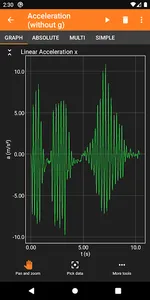Did you know that you are carrying a 3D magnetometer? That you can use your phone as a pendulum to measure earth's local gravitational acceleration? That you can turn your phone into a sonar?
phyphox gives you access to the sensors of your phone either directly or through ready-to-play experiments which analyze your data and let you export raw data along with the results for further analysis. You can even define your own experiments on phyphox.org and share them with colleagues, students and friends.
Selected Features:
- A selection of pre-defined experiments. Just press play to start.
- Export your data to a range of widely used formats
- Remote-control your experiment through a web interface from any PC on the same network as your phone. No need to install anything on those PCs - all you need is a modern web browser.
- Define your own experiments by selecting sensor inputs, defining analysis steps and creating views as an interface using our web-editor (http://phyphox.org/editor). The analysis can consists of just adding two values or using advanced methods like Fourier transforms and crosscorrelation. We offer a whole toolbox of analysis functions.
Sensors supported:
- Accelerometer
- Magnetometer
- Gyroscope
- Light intensity
- Pressure
- Microphone
- Proximity
- GPS
*some sensors are not present on every phone.
Export formats
- CSV (Comma separated values)
- CSV (Tab-separated values)
- Excel
(if you need other formats, please let us know)
This app has been developed at the 2nd Institute of Physics A at the RWTH Aachen University.
--
Explanation for the permissions requested
If you have Android 6.0 or newer, some permissions will only be asked for when needed.
Internet: This grants phyphox network access, which is required to load experiments from online resources or when using the remote access. Both are only done when requested by the user and no other data is transmitted.
Bluetooth: Used to access external sensors.
Read external storage: This is may be necessary when opening an experiment stored on the device.
Record audio: Required to use the microphone in experiments.
Location: Used to access GPS for location-based experiments.
Camera: Used to scan QR codes for external experiment configurations.
phyphox gives you access to the sensors of your phone either directly or through ready-to-play experiments which analyze your data and let you export raw data along with the results for further analysis. You can even define your own experiments on phyphox.org and share them with colleagues, students and friends.
Selected Features:
- A selection of pre-defined experiments. Just press play to start.
- Export your data to a range of widely used formats
- Remote-control your experiment through a web interface from any PC on the same network as your phone. No need to install anything on those PCs - all you need is a modern web browser.
- Define your own experiments by selecting sensor inputs, defining analysis steps and creating views as an interface using our web-editor (http://phyphox.org/editor). The analysis can consists of just adding two values or using advanced methods like Fourier transforms and crosscorrelation. We offer a whole toolbox of analysis functions.
Sensors supported:
- Accelerometer
- Magnetometer
- Gyroscope
- Light intensity
- Pressure
- Microphone
- Proximity
- GPS
*some sensors are not present on every phone.
Export formats
- CSV (Comma separated values)
- CSV (Tab-separated values)
- Excel
(if you need other formats, please let us know)
This app has been developed at the 2nd Institute of Physics A at the RWTH Aachen University.
--
Explanation for the permissions requested
If you have Android 6.0 or newer, some permissions will only be asked for when needed.
Internet: This grants phyphox network access, which is required to load experiments from online resources or when using the remote access. Both are only done when requested by the user and no other data is transmitted.
Bluetooth: Used to access external sensors.
Read external storage: This is may be necessary when opening an experiment stored on the device.
Record audio: Required to use the microphone in experiments.
Location: Used to access GPS for location-based experiments.
Camera: Used to scan QR codes for external experiment configurations.
Show More



